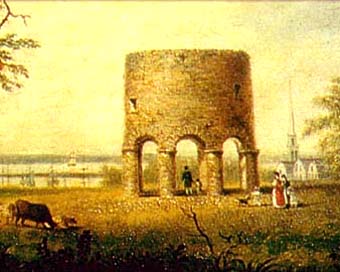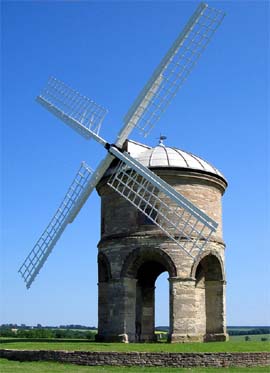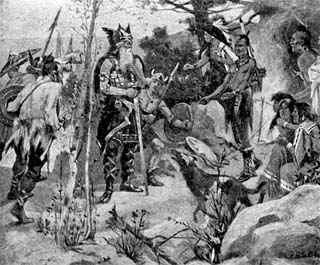pop up description layer
HOME
Cryptozoology UFO Mysteries Aviation Space & Time Dinosaurs Geology Archaeology Exploration 7 Wonders Surprising Science Troubled History Library Laboratory Attic Theater Store Index/Site Map Cyclorama
Search the Site: |
|
The Mysterious Tower at Newport In the center of one of the most popular and ritzy seashore resorts on the eastern shore of the United States stands a small tower. At only 28 feet in height and about 24 feet across, most visitors to Newport, Rhode Island don't give it much notice. It stands quietly in a little park behind a protective fence, a vertical cylinder of rough stone supported by eight arches sitting upon eight columns. The vast majority of tourists that pass by it never realize that it has been the center of an archaeological controversy that is over a century old. Most historians accept that the tower is the remains of an old stone windmill built in colonial times by Benedict Arnold, grandfather of the Revolutionary War patriot/traitor with the same name. Arnold was governor of Rhode Island at the time and owned the land where the tower is located. Arnold mentions the structure in his will composed in 1677 referring to it as "my stone built Wind Mill." Later records show it was used as a lookout tower by the Americans and an armory by the British during the Revolution. The design of the mill, a cylinder supported by columns, is very similar to the Chesterton Windmill in Warwickshire, England. Some historians suggest that Arnold saw the Chesterton Windmill as a child and then duplicated the design when he went to build his own stone windmill after he'd emigrated to America. In 1990 the construction date of the newport tower was estimated to be between 1635 to 1698, based on carbon-14 dating of the mortar. This is just about the time frame in which Arnold would have built the tower, if indeed he had.
So what's the mystery? Why does anybody think the tower is anything than what it seems to be? The Norse Theory Theories that the tower might be something more than Arnold's mill started around 1837. That year a Danish archaeologist named Car Christian Rafn proposed in his book, Antiquitates AmericanŠ, that the Vikings had explored the coast of North America centuries before Columbus's 1492 voyage. Rafn was particularly interested in the Norse sagas that involved a place called Vinland which Rafn thought must be New England. Rafn had studied strange markings found on Dighton Rock in nearby Massachusetts and come to the conclusion they were of Scandinavian origin. This led him to suggest that the Newport tower was originally part of an early Norse settlement. Rafn's ideas about the Norse origin of the tower were so persuasive that poet Henry Wadsworth Longfellow included it in his Viking ballad "The Skeleton in Armor". Though the poem was only fiction, it helped popularize the theory and strengthen the connection of the tower with the idea of an early Norse settlement of New England within the public's mind. Over a hundred years later, in 1942, archaeologist Phillip Answorth Means took up Rafn's arguments in his own book, The Newport Tower. Means thought the tower resembled round churches found in Scandinavia and suggested that Arnold simply converted an already-existing structure to a windmill, rather than building the tower from the ground up. He listed a number of reasons for this thinking, though not all had merit. For example, Means contended that the existence of a fireplace (the remains of which can be seen on what would have been the upper floor of the tower) shows that the building was not originally constructed as a mill. Means argues that the operation of the mill would generate too much flammable dust for anyone to risk installing a fireplace in such a building. Though there is logic behind this thinking, one can find numerous examples throughout Europe of fireplaces installed in mills. The type of fireplace installed in most of these windmills is also similar to the fireplace in the Newport Tower because the flu exits through the side wall, rather than the roof. Since the tops of most windmills were designed to turn so the blades could face the wind, running the flu straight up through the roof was not practical. Means was also dismissive of the comparison of the Newport tower with Chesterton Mill, citing work by British historian Rex Wailes. Wailes was of the opinion that Chesterton had originally been built as an observatory and only converted to a windmill after Arnold had left for America. More recent research has shown, however, that Chesterton was always a mill and it is entirely plausible that Arnold, or some other member of the Newport community who acted as the architect for the Newport Tower, could have seen it before traveling to North America and decided to duplicate the design.
Four years after Mean's book came out two professors, P. Luvfold and M. Bjorndal, found what appeared to be a Swedish-Norwegian runic inscription on the west side of the tower, 14 feet above the ground. The inscription included a date: 1010. While this would seem to support the Norse theory, the number of years involved since the proposal of the theory in 1837 to the discovery of the rune makes it impossible to discount that the markings were part of a hoax perpetrated during the intervening century. Portuguese or Chinese? The Norse theory isn't the only origin of the Newport Tower that people have advanced, however. Early in the 20th century, historian Edmund Delabarre proposed that the tower was constructed by Portuguese navigator Miguel Cort-Real. Delabarre believed Cort-Real was shipwrecked in the area around 1501 or 1502 during a search for his lost brother, Gaspar, in Narragansett Bay. Supporters of the Portuguese theory point to the large number of octagonal rotundas, particularly the main tower at the Castle of Tomar found in Portugal that bear some resemblance to the Newport tower. Iin his book 1421: The Year China Discovered the World, author Gavin Menzies argues that ships from the Chinese fleet of Admiral Zheng He circumnavigated the world and may have constructed the tower at Newport. Menzie's writings are extremely controversial, however, and not accepted by most mainstream scientists. So, who did build the Newport Tower? Benedict Arnold, Vikings, Miguel Cort-Real or Admiral Zheng He? The only theory with evidence to back it up is the Arnold theory. Excavations in and around the tower have unearthed only artifacts consistent with the colonial period: no Norse, Portuguese or Chinese items at all. As critics of the Arnold theory point out, this lack of pre-colonial objects doesn't prove that the building itself isn't much older. It is hard to believe, however, that if the construction actually predated the colonial period that the builders would not have left tools or construction materials behind for archeologists to find. Critics of the Arnold theory also argue that at the time of the supposed construction' the colony at Newport was preoccupied with Indian attacks and could not have taken on such a resource-ntensive project such as a stone windmill tower. While this tower undoubtably was more difficult to build than a wooden structure, the destruction of an earlier wooden windmill by a storm may have encouraged Arnold to invest in a heavier structure. The construction may have been a challenge for the colonists, but it would have been just as difficult or even more difficult for the groups mentioned in the alternate theories. Why would Cort-Real bother with building a stone signal tower when a wooden one would have done just as well? It may never be possible to "prove" the origin of the tower to all party's satisfaction. It will most likely remain the object of controversy, sitting quietly on the hillside, behind its protective fence, watching the modern world go by while keeping to itself the secrets of its unknown history. Copyright Lee Krystek 2007. All Rights Reserved. |
|
Related Links |
|
|






